How to Feed & Maintain your Sourdough Starter
You’ve done it! You’ve created a living batter filled with wild yeast. Now let’s see how to feed & maintain your sourdough starter.
If you haven’t made your starter yet, visit this post to see how to make a sourdough starter from scratch.
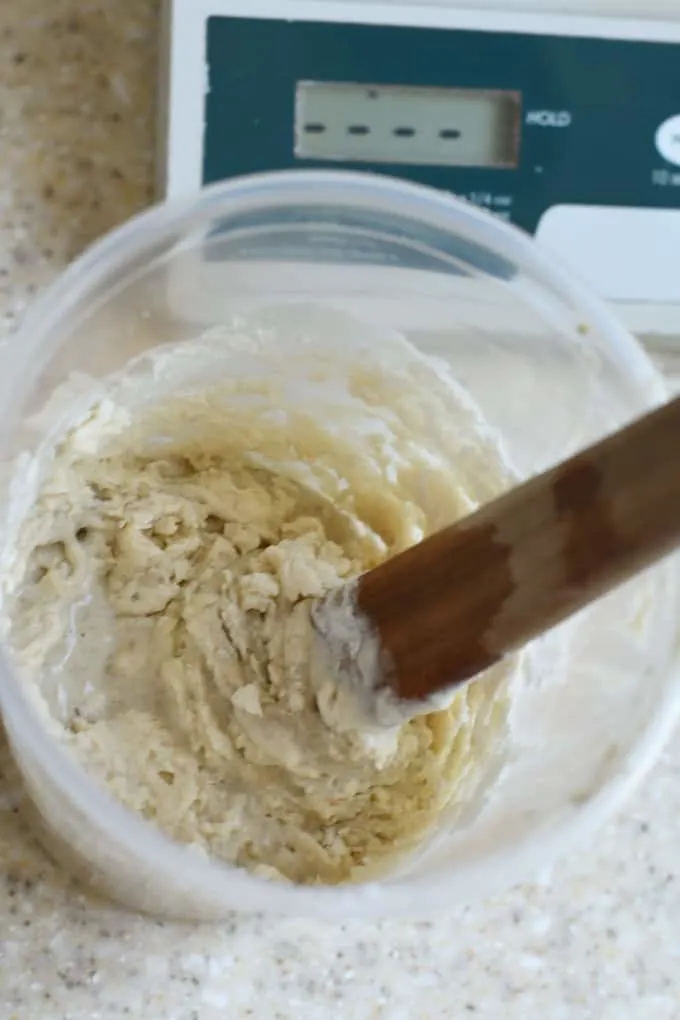
Right off the bat I’m going to say that there are a million ways to feed, maintain and use a sourdough starter. In fact, after you’re done reading this post, you should read through my instructions for How to keep a small sourdough starter to see of that method would work better for you.
I am going to outline for you how I maintain my sourdough starters. I tend to have a fairly relaxed attitude towards the process. It works for me and I think my approach can work for you if you don’t bake bread every single day (and even if you do).
At the end of the post you’ll find a how-to card that lists the ingredient amounts and steps to follow each time you feed your starter.
But first I’m going to give you all the how’s and why’s and try to answer any questions you might have.
Tips for using and maintaining your sourdough starter:
- Since I don’t bake every day, I keep my starters (yes, I have 3) in the refrigerator.
- If I’m making a 2-day recipe (most of mine are) I take the starter out of the refrigerator early in the morning of the day I’m making the dough. If the starter is inactive I feed it right away and it should be ready by early afternoon.
- If I’m making a 1-day recipe, I’ll take the starter out the night before and feed it if it’s inactive. It should be ready to use first thing in the morning.
- When the starter is cold from the refrigerator, I feed the starter using fairly warm water, warmer than body temp. The warm water will jump-start the cold starter.
- If the starter has been fed within the last 2-3 days, and has been refrigerated, you can probably go ahead and use it without feeding.
- If you’re not sure if the starter is active, drop a dollop into a bowl of water to see if it floats. If it does, it’s ready for baking.
- I write all my sourdough recipes to use 8 oz of active starter. After using 8 oz of starter in the recipe, I’m left with 4 oz of starter, exactly the right amount for feeding.
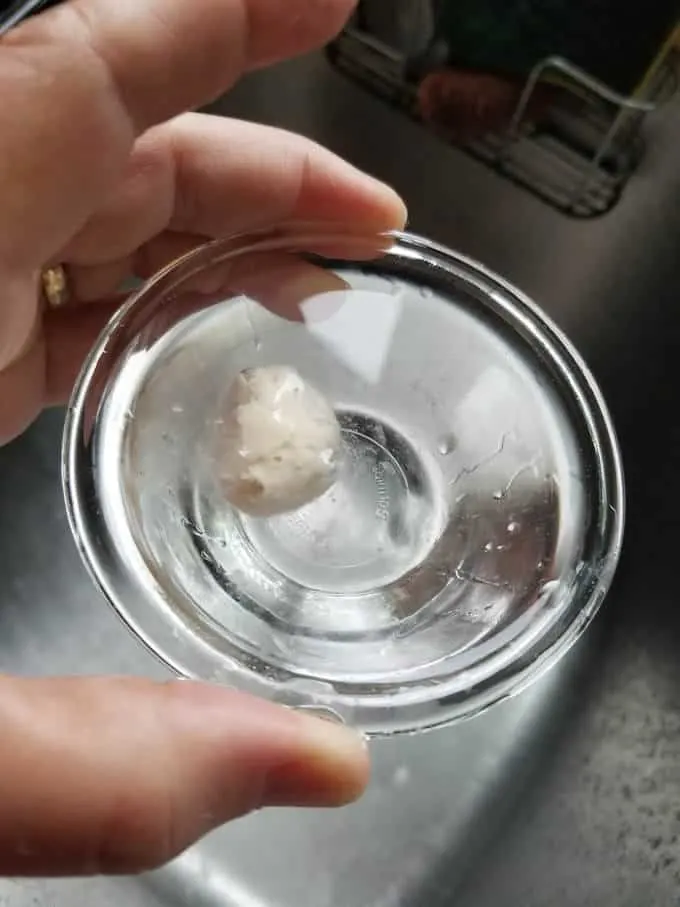
Schedule for feeding your sourdough starter:
- Your starter needs to be fed about 1x per week if refrigerated, and every day if left at room temperature.
- Generally, about 5-6 hours after feeding my starter is ready. The time may vary based on room temp, dough temp, etc. The starter should have doubled in volume and started to recede and/or pass the float test.
- I take my starter out of the refrigerator once a week for feeding, even if I’m not baking. Although, truth be told, I often go longer than a week between feedings and I haven’t killed it yet.
- Did you know you can dry your sourdough starter? Dried starter can be kept indefinitely.
- After you’ve removed the portion of starter for baking, feed the starter again and leave it at room temperature for 3-4 hours before putting it back in the refrigerator.
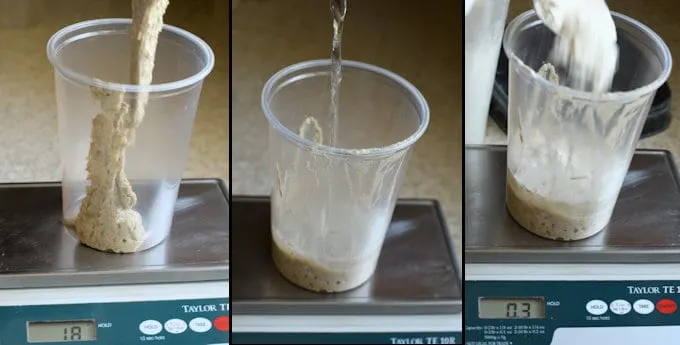
FAQs about feeding & maintaining Sourdough Starter:
Honestly, I’ve gone longer than a month without feeding my starter and I haven’t killed it yet. Give it a feeding and see if it wakes up. If it’s alive, keep feeding it until it is reliably doubling in size within 4-5 hours.
If you go more than about 2 weeks between feedings, you might want to give the starter 2-3 feedings before using. A starter that hasn’t been fed for weeks will be quite sluggish and your dough won’t be as lively.
If your starter was fed a day or two before, it’s possible to use the starter straight from the refrigerator. Give it a float test to make sure it’s active. The dough may take a little longer to ferment since the temperature of the dough will be colder.
It’s called “hooch” and don’t worry, your starter is still alive. Just stir that water back into the starter before feeding. Again, you might need 2 feedings to completely revive the starter since it’s been quite dormant.
To maintain your starter at 100% hydration it is best and most accurate to weigh your ingredients. If you’re just a little bit off every time you feed, eventually, your starter could be thrown out of balance.
No problem, use the amount of starter called for in the recipe. Then weigh out 4 oz of the remaining starter for feeding and discard the rest.
If you continually feed the starter without discarding, you’ll end up drowning in starter.
Yes, even if the discard is not active enough for baking bread, you can add it to many other recipes as a flavor and texture enhancer.
Unless you’re going away for an extended time, your starter should be just fine for a couple of weeks in the refrigerator. If you’ll be gone really long-term, put the starter into the freezer or dry it. Frozen or dried starter will need several feedings to rejuvenate.
If you appreciate this detailed information, I’d really appreciate a 5-star review.
How to Feed Sourdough Starter
Ingredients
- 4 oz unfed sourdough starter
- 4 oz all purpose flour
- 4 oz water (room temperature)
Instructions
- Weigh 4 oz of your unfed starter into a clean container. Discard the extra starter (see note)4 oz unfed sourdough starter
- Add the flour and water and mix until combined. Set aside at room temperature.4 oz all purpose flour, 4 oz water
- The starter is ready to use when it has doubled in volume and a small spoonful floats when dropped into a bowl of water. This generally takes 4-5 hours but the time can vary based on dough temperature and room temperature.
- If you do not plan to bake with the starter on the day it is fed, refrigerate 3-4 hours after feeding.
- Feed refrigerated starter weekly. If you go longer than a week without feeding, you may want to give the starter two feedings before using.
Would you like to save this recipe?
As an Amazon Associate and member of other affiliate programs, I earn from qualifying purchases.

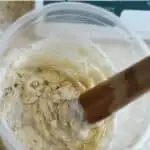





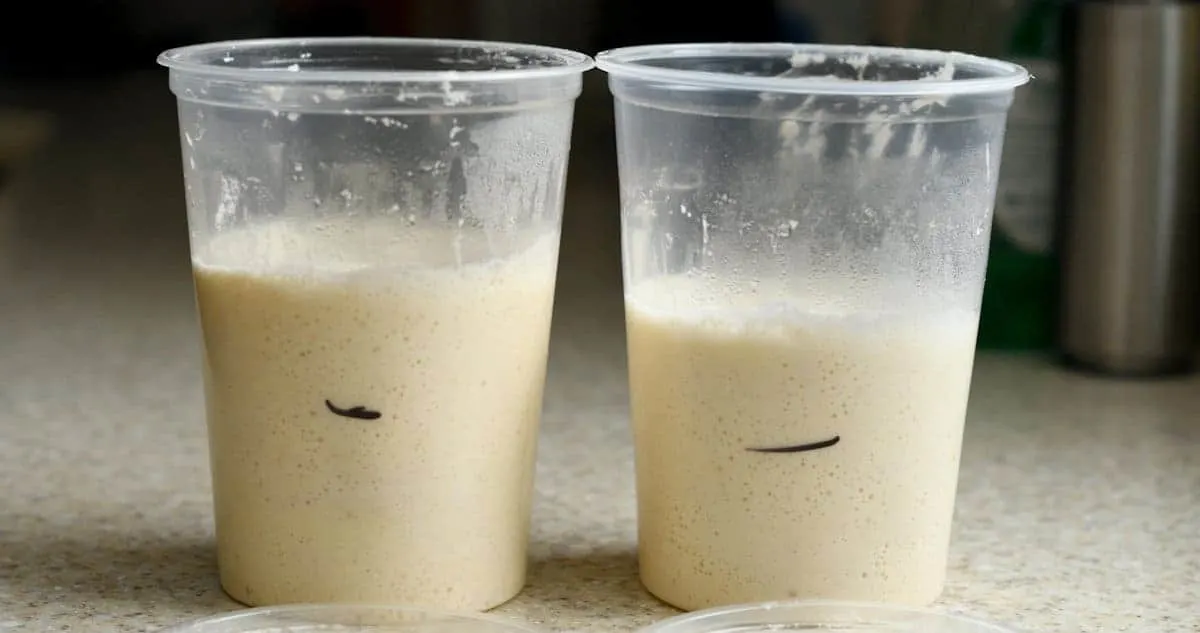
Thank you this is so helpful! I love that you try to answer everything about cold starter, dormant starter, etc! It’s a one stop shop for newbies!!!
Hi there, I have an over 50 year old starter that my friend received as a wedding gift 45 years ago. It came from a grandmother in Sweden. I’m guessing it’s honestly about 80 years-old. The pressure to take good care of it is huge! However, my lifestyle and baking habits are not in keeping with that! I’ve left this starter in the fridge for 5 months at a timeI feed it 2 cups of Bob’s Red Mill organic flour and two cups of filtered water the night b4 I use it. It always performs and gets bubbly etc. I then take out my 8 oz and proceed baking. It does always have a hooch, I often flip it in the refrigerator to incorporate it. My question is, am I doing this precious starter a disservice? Am I going to kill it? I’m very concerned. My other question is, often my bread or biscuits are very dense. Is this due to the long time between feeding? Thank you in advance!
Tina
Obviously you haven’t killed it yet! I have left my starter for quite a long time occasionally. They aren’t that easy to kill. I would say you might be getting dense bread if your starter is a bit sluggish. Maybe try doing two feeding before you’re ready to bake.
After you’ve removed the portion of starter for baking, is it necessary to feed the starter again and put it back in the fridge ? Or can I just put the starter back in the fridge and feed it again before the next time I use it?
The leftover starter will need a feeding to stay alive. If you just put the unfed starter in the fridge eventually it would run out of food to keep producing the yeast.
When I take my starter out of fridge do I feed it for 5 days before I can make dread
No. Once you have an established starter you just need to keep it active. If the starter hasn’t been fed in several days you should fed it 1x when you take it out of the fridge. Wait for it to rise to about double in size then use it in your recipe. If the starter was fed within the last couple of days it may still be active enough to use when you take it out of the fridge. As you use your starter you’ll get a sense of when you need to feed it before using and when you can use it right away. Generally, if I take my starter out I can tell if it hasn’t reached it’s peak since it’s been fed (usually because I put it in the fridge shortly after feeding).
I fed my starter and completely forgot to mix the dough last night. It has been sitting on the counter for almost 20 hours. Did I ruin it? Should I mix the flour to make dough ball or throw it out?
You definitely don’t need to throw out the starter, but if you left it out at room temperature you should probably feed it again before making your dough. Feed it. Wait for it to double in volume then make your dough.